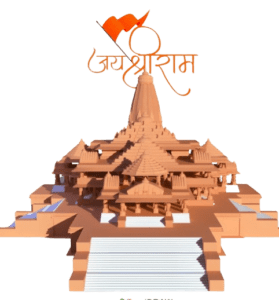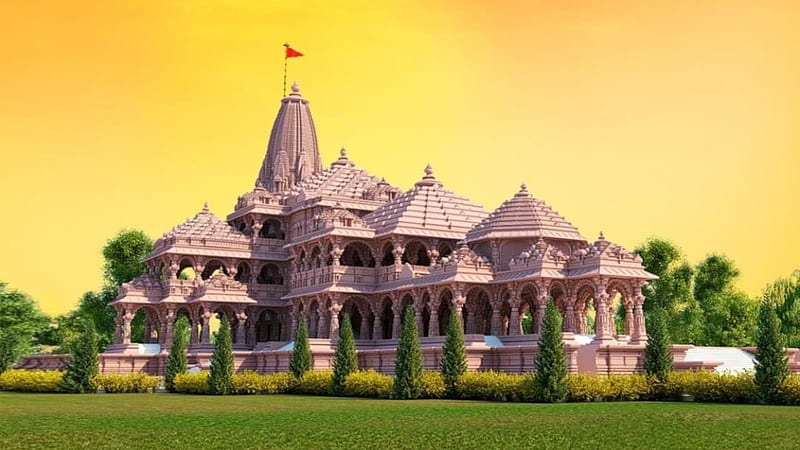About Ram Mandir
Ram Mandir, the proposed temple dedicated to Lord Ram in Ayodhya, holds immense cultural and religious significance for Hindus all over the world. It stands as a symbol of faith and devotion, representing the rich heritage and traditions of the Hindu community.
Excitement fills the air as Prime Minister Narendra Modi is set to inaugurate the Ayodhya Ram Temple on January 22, 2024. The pran-partisha (consecration) ceremony will witness the installation of the idol of Ram Lalla in the sanctum-sanctorum (garbha-griha) of the temple.
For devotees eager to witness this historic moment, entry to the grand temple will be permitted starting January 24. It marks a significant occasion, inviting believers to partake in the spiritual essence of the Ayodhya Ram Temple from this auspicious date onwards.
Historical background of the Ayodhya dispute:
The Ayodhya dispute traces its roots back to the 16th century the Babri Masjid was constructed on the site believed to be the birthplace of Lord Ram. The dispute intensified over the years, leading to legal battles and political conflicts.
This article aims to provide a comprehensive account of the journey of Ram Mandir, from its ideation to the recent Supreme Court verdict. It explores the historical, legal, and cultural aspects of this iconic temple, shedding light on both the controversies and the positive impact it has had on Indian society.
Ideation of Ram Mandir
Ancient scriptures and references to Lord Ram:
The significance of Ram Mandir can be traced back to ancient texts like the Valmiki Ramayana. Written by Sage Valmiki, the Ramayana narrates the epic story of Lord Ram’s life, showcasing his divine qualities and character. It has served as a guiding scripture for millions, reinforcing the importance of establishing a temple in his honor.
In the 19th century, Hindu nationalism witnessed a resurgence, leading to increased calls for the construction of Ram Mandir. Organizations such as the Ram Janmabhoomi Nyas played a crucial role in mobilizing support and keeping the demand for the temple alive.
The Babri Masjid demolition in 1992 marked a turning point in the Ayodhya dispute, sparking widespread controversy and unrest. The demolition gave impetus to the demand for a Ram Mandir and set the stage for a string of legal battles and public movements advocating for the temple’s construction.
In a historic judgment on November 9, 2019, the Supreme Court ruled in favor of the construction of Ram Mandir at the disputed site. The detailed analysis of the judgment showcases the court’s attempt to address the concerns of all parties involved and lay the groundwork for a peaceful resolution.
After the SC verdict, prime minister Narendra Modi performed the Bhumi Poojan ceremony on August 5, 2020, and laid the foundation stone of the temple.
The Symbiotic Relationship between Ram Mandir and Ayurveda
Ayurveda has always been an integral part of Hindu traditions and rituals. At Ram Mandir, Ayurvedic practices are incorporated into worship and rituals, enhancing the spiritual experience of devotees. The temple also houses Ayurvedic herbs that hold ritualistic importance. Furthermore, yoga and meditation play a crucial role in balancing the body, mind, and soul, bringing devotees closer to a state of union with the divine.
The influence of Ayurveda extends beyond worship and rituals into the very architecture and design of Ram Mandir. Construction techniques aligned with Vedic principles and the use of natural materials showcase the deep connection between Ayurveda and the temple. Moreover, sacred gardens within the temple premises incorporate Ayurvedic plants, providing healing spaces for devotees to immerse themselves in nature’s therapeutic aura.
Ayurveda, often referred to as the science of life, has its origins deeply rooted in ancient Vedic texts and the wisdom of rishis. Its core principles revolve around the balance of doshas, elements, and a holistic approach to well-being. Ayurvedic treatments aim to harmonize the mind, body, and spirit through natural remedies and therapies. Today, Ayurveda is experiencing a global resurgence, with its relevance recognized by modern medicine and its integration into healthcare systems worldwide. Ayurvedic tourism offers a unique opportunity to explore India’s healing destinations and experience the rejuvenating power of nature.
Ayodhya Ram Mandir:Structure

Ram mandir is designed by chief architect, Chandrakant Bhai Sompura, whose grandfather, Prabhakar ji Sompura, had designed the Somnath Temple, along with his son, Ashish Sompura. The 79-year-old architect was appointed in 1992. Sompura mentioned that the Ram Mandir is being built in the Nagara style, following the principles of Vastu Shastra. The entrance on the east would be built in the Gopuram style, which represents the temples of the south. The walls of the temple would display artworks depicting the life of Lord Ram.
Within the sacred premises, two idols of Lord Ram find their place. The first, discovered in 1949, has resided in a tent for decades. The second, a majestic statue visible from a distance, sculpted by artist Arun Yogiraj, captures Lord Ram in a charming five-year-old form, standing at 51 inches in black stone.
A 2,100-kg bell, a significant addition to the temple, is being brought from the bell-manufacturing hub of Etah. Standing at 6 ft tall and 5 ft wide, this bell, costing Rs 21 lakh, adds an auditory dimension to the spiritual ambiance.
The doors and windows, integral to the temple’s grandeur, are crafted from Teak wood sourced from Maharashtra’s Chandrapur. This wood, known for its longevity of over 100 years, ensures that the temple’s architectural splendor stands the test of time.
The commencement of the construction of grand doors and windows is marked by a ceremonial ritual, scheduled between June 26 and 30, adding a cultural significance to the meticulous craftsmanship.
Darshan Timings
Sunday to Saturday:
- Morning: 7:00 AM to 11:30 AM
- Evening: 2:00 PM to 7:00 PM
Morning Aarti (Shiringar Aarti) Timings
- Sunday to Saturday:6:30 AM
Evening Aarti (Sandhya Aarti) Timings
-
Sunday to Saturday: 7:30 PM
Ayodhya Ram Mandir: Timeline
To understand the historical journey of Ayodhya Ram Mandir, let’s take a look at the key events:
- 1528-1529: Mughal emperor Babur builds Babri Masjid
- 1850s: Communal violence begins over the land
- 1949: Ram Idol found inside the mosque, escalating communal tension
- 1950: Two suits filed in Faizabad civil court seeking permission to worship the idol
- 1961: UP Sunni Central Wakf Board demands the removal of the idol
- 1986: District Court opens the site for Hindu worshippers
- 1992: Babri Masjid demolished on December 6
- 2010: Allahabad HC rules three-way division of disputed area among Sunni Waqf Board, Nirmohi Akhara, and Ram Lalla
- 2011: SC stays Allahabad HC order
- 2016: Subramanian Swamy files plea in SC, seeking the construction of Ram Temple
- 2019: SC accepts Ayodhya as the birthplace of Lord Ram, hands over the entire 2.77 acres of disputed land to the trust, and orders the government to give 5-acre land to Sunni Waqf Board as an alternate site
- 2020: PM Modi performs Bhumi Poojan and lays the foundation stone
Plan your visit accordingly, and immerse yourself in the rich history and spiritual ambiance of Ayodhya Ram Mandir.
how to reach Ayodhya
By Air:
- You can catch a flight to Ayodhya Airport from major cities across India.
- The airport is well-connected to the city center, and you can easily reach it by taxi or auto-rickshaw.
By Road:
- Ayodhya has excellent road connectivity to nearby cities and towns.
- You can hire a taxi or use public transportation, such as buses, for a comfortable journey to Ayodhya.
- The airport is situated approximately 8-10 km from the city center.
By Train:
- The Ayodhya Junction is the nearest major railway station.
- After reaching Ayodhya Junction, you can cover the remaining distance to Ayodhya Airport by taxi or auto-rickshaw, which is around 6-8 km.
Choose the mode of transportation that suits you best and embark on a hassle-free journey to experience the cultural and spiritual richness of Ayodhya.
FAQs: The Ayodhya Ram Mandir
- Q: When was the chief architect, Chandrakant Bhai Sompura, appointed for the project?
- Ans: Chandrakant Bhai Sompura took charge in 1992, bringing his rich legacy to the forefront of the temple’s design.
- Q: How tall is the temple bell, and what is its significance?
- Ans: The 2,100-kg bell stands at 6 ft tall and 5 ft wide, contributing both visually and auditorily to the spiritual ambiance.
- Q: What is the artistic significance of the walls within the temple?
- Ans: The walls showcase artworks depicting the life of Lord Ram, adding a visual narrative to the spiritual journey of the devotees.
- Q: Why is Teak wood chosen for the doors and windows?
- Ans: Teak wood, sourced from Maharashtra’s Chandrapur, is selected for its exceptional longevity, ensuring the endurance of the temple’s grandeur for over a century.
- Q: When will the construction of the grand doors and windows commence?
- Ans: The ceremonial ritual marking the initiation of the construction is scheduled between June 26 and 30, adding cultural significance to the craftsmanship.
- Q: When is the inauguration of Ayodhya Ram Temple, and who will perform it?
- Ans: Prime Minister Narendra Modi will inaugurate the Ayodhya Ram Temple on January 22, 2024, during the pran-partisha ceremony.
- Q: When can devotees visit the Ayodhya Ram Temple after the inauguration?
- Ans: Devotees can enter the grand temple starting January 24, marking a significant occasion to partake in its spiritual essence.
- How can I reach Ayodhya by air?
- A: You can book flights to Ayodhya Airport from major Indian cities. The airport is conveniently connected to the city center via taxi or auto-rickshaws.
- Q: Is Ayodhya well-connected by road?
- A: Yes, Ayodhya is well-connected by road to nearby cities and towns. You can hire a taxi or use public transportation like buses to reach Ayodhya from nearby locations.
- Q: What is the nearest major railway station to Ayodhya?
- A: The Ayodhya Junction is the nearest major railway station. From there, you can take a taxi or an auto-rickshaw to reach Ayodhya Airport, which is around 6-8 km away.
